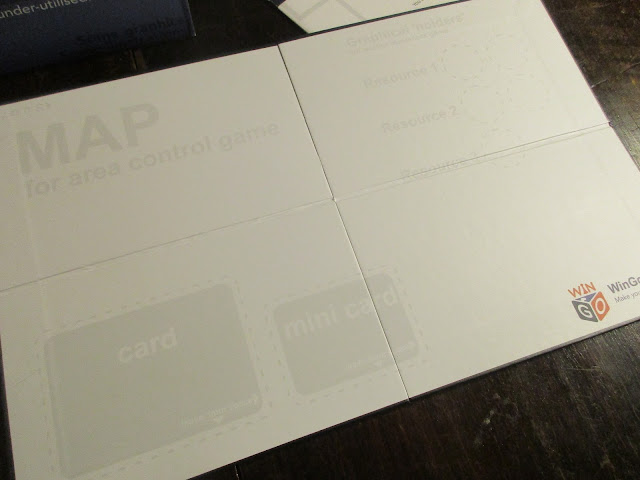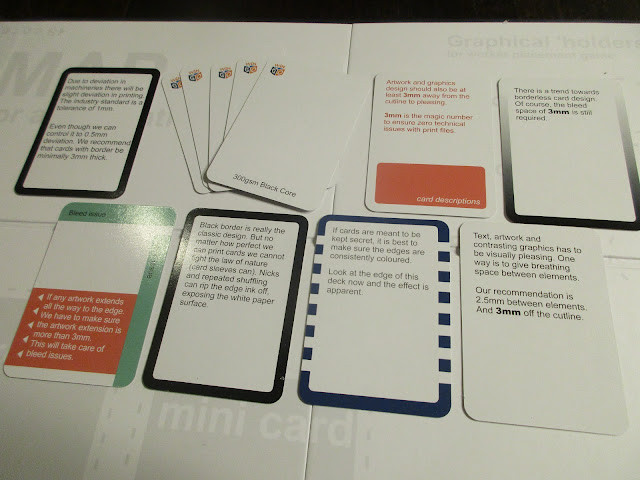 |
| This is not a game...yet.Game Designer's Kit Publisher: WinGo Games |
Disclaimer Support me on Patreon!
So, do you like to play board games and have a few ideas of your own? You're thinking of starting on the creative journey of designing a board game? That's great! Now you're probably wondering where to start. Personally, I start out by writing out a rough draft of the rules. Once I have those written I'll have a better idea of the components I'll need to make a playable prototype. Then comes time to build a prototype to start testing out the rules and mechanics I've been thinking about. But building a prototype is one of the more challenging parts of designing a game. You can have all the wonderful ideas you like in your head, and even written on paper, but until you have a prototype to actually test things out you'll never know if your game works, if it's fun, or what it's missing.
So now that you've gotten to the point where you need to make a prototype you'll need to find appropriate components. Some games use standard dice, cards, pawns, tokens, tiles, and boards, but chances are you'll also have at least a few components that are different than your usual fare. Maybe miniatures, custom dice, custom shaped tokens or tiles, wooden bits, or something more exotic. For the custom components you'll probably have to spend some time in a craft store and then at a desk with a knife and markers or spend a lot of money for custom pieces from The Game Crafter. For the standard components you'll be able to piece together bits from older games, thrift store finds, or just buy them from a source like The Game Crafter or Print & Play Games.
There must be an easier way, you might say, than piecing everything together from scratch. So you search for a game designer's kit, and one of the things you'll find is this kit from WinGo Games. Is this what you're looking for? Let's look closer and find out.
Overview:
 |
| Need ideas for what to put on the side of a game box? Check the box! |
Upon opening the box you'll find it packed with all sorts of goodies. There are two punchboard sheets, a small quad fold game board, custom dice, cubes, a mini, metal coin, tuck box of cards, 'rulebook', and more. These are all great, but you'll quickly realize that this is not a game designer's kit. There's a very limited number of components in here. However there is a pretty big variety of components. It's a great sampling of the types of components that WinGo can produce for your games.
 |
| This is everything that's included. Not quite enough to really design a game, but still pretty useful. |
The first punchboard contains a number of tokens: 15 coins, 15 blue flames, and 12 hearts. The second punchboard contains a character standee (there's a plastic base in the kit), TNT token with a countdown spinner (there's a plastic axle for the spinner in the kit), and a WinGo logo 3d construct.
 |
| A great example of how to plan bleed areas for tokens. |
 |
| Showing how punchboard items can be used to make 3D objects. |
 |
| These are pretty cool once punched and constructed. |
There are nine meeples in three different colors (red, orange, and yellow) and each color has one each of three different designs.
 |
| Meeples can be custom shapes! |
The kit also contains 18 high quality acrylic cubes (they almost feel like glass). There are three each in six different colors: red, green, blue, purple, black, and white.
 |
| These are actually pretty awesome. I'd love to have a huge bag of these! |
A plastic miniature of a character (a cave man shaman in a bear skin?), two custom dice, and a sample metal coin round out the bits and pieces in the kit.
 |
| This is the same character as the standee. |
 |
| The coin is slightly bigger and thicker than a US penny. |
There's also a small quad fold game board that measures about 13.5" by 8.5". The game board has, lightly printed, outlines of ideas for things to print on a game board. There are a few spots outlined for tokens that could be used in a worker placement game, outlines of cards for decks, a sample score track, and a section for an area control map.
 |
| It's a small board, but gives some good ideas for how to use a board. |
Inside the box is also a smaller tuck box filled with cards of different types and sizes. Just like the main box, the tuck box has labels for all sorts of information you may want to print on a tuck box.
 |
| Just like with the main box, the tuck box is filled with helpful tips. |
Inside the tuck box are four different types of cards. They vary in size and material, including a small deck of 300gsm black core mini cards as well as several larger decks: 300gsm blue core bridge, 300gsm purple core poker, and premium 350gsm ivory core linen finish poker. These provide a great example of the different types of cards available and let you see exactly what the difference between 300gsm and 350gsm is, or black core vs blue core. Honestly, I couldn't tell much difference between the different cores (although you can see the difference when the cards are stacked), but going from 300gsm to 350gsm with a linen finish is a really noticeable jump in quality.
 |
| Four different card types and sizes. |
 |
| The mini cards have the exact same tips and examples on them, just smaller. |
 |
| The rulebook is filled with all sorts of useful information if you intend to have your game professionally produced. |
Finally, the box also has a plastic insert that has a spot to hold the mini as well as a depression for the dice (although it was too tight of a fit) and another depression to hold the tokens and other components. There's also a cardboard divider that holds the insert on one side and the tuck box on the other.
 |
| The insert is more example than useful. |
Final Thoughts:
WinGo Games calls this a Game Designer's Kit, however, I'd call this a game publisher's kit, or a game developer's kit. As a game designer I'm looking for a quantity of mostly generic components rather than a few very specialized components. I'm also not concerned with the difference between types of card cores or weights, although it's nice to see first hand what someone means when they say 350gsm linen finish ivory core cards are a stretch goal on a Kickstarter.
 |
| From the side you can see the different core types: purple, blue, ivory, and black. |
 |
| All of this is useful, but there's not enough to truly be a designer's kit. It's a great manufacturer's sample kit though! |
Where the WinGo kit is really useful though, is for those thinking about self-publishing. For those that want to go further than just designing a game, but actually producing a game, this kit provides a wealth of information. The samples are great for seeing what can be done and helping you decide between different options. What kind of cards do you want? How should the artwork be prepared? Do you want wooden components? How about standees vs miniatures? Can you get the box embossed, foil stamped, or spot UV treated? What can custom dice look like? What kind of information should you have on your game box? These are all questions that this kit answers or at least guides you in the right direction to learn more.
 |
| There are tons and tons of tips in the rulebook. This is super useful if you intend to self-publish. |
So, while the title of this product is misleading, if you are thinking of publishing games, this is a wonderful sample kit that is well worth grabbing at the next convention you see it at. It'll start you off in the right direction for completing your game efficiently and effectively once the general game design is finished.
 |
| These may make it into a prototype of mine... We'll see. |
Will I use this kit to design a game? Probably not, although I may use a few of the components here or there. Do I think this is a useful kit? Definitely, if you want to take your games to the next level on your own. There's a ton of information, some great samples, and some cool examples of the quality product that WinGo Games can manufacture. And keep an eye out in the future for updated and larger kits, too!

Did you like this review? Show your support: Support me on Patreon! Also, click the heart at Board Game Links
 , like GJJ Games on Facebook
, like GJJ Games on Facebook  , or follow on Twitter
, or follow on Twitter  . And be sure to check out my games on Tabletop Generation.
. And be sure to check out my games on Tabletop Generation.





















No comments:
Post a Comment